Introduction
Table of contents
Ever wondered if your optimizations are actually working? Want to see what happens behind the scenes when we optimize web pages? In this case study, we’ll walk you through our process of on-page optimization, focusing on the keyword Separation Anxiety Training. We noticed we were ranking for Separation Anxiety Trainer but not for Separation Anxiety Training which was very interesting to us.
Our goal was to rank for the Separation Anxiety Training. Let’s dive into how we tackled this and improved our search engine ranking.
Article Overview
This article is structured to make it easy for you to follow along and find what interests you most. Here’s a quick overview:
Steps Taken to Improve Rankings:
- Analyzed keywords we were already ranking for.
- Research target keywords.
- Optimized content using SemRush and SE ranking tools.
- Published changes and monitor performance on Google Search Console
Analysing keywords that we are already ranking for
Keywords like Separation Anxiety Trainer and dog trainer for separation anxiety were doing very well for us.
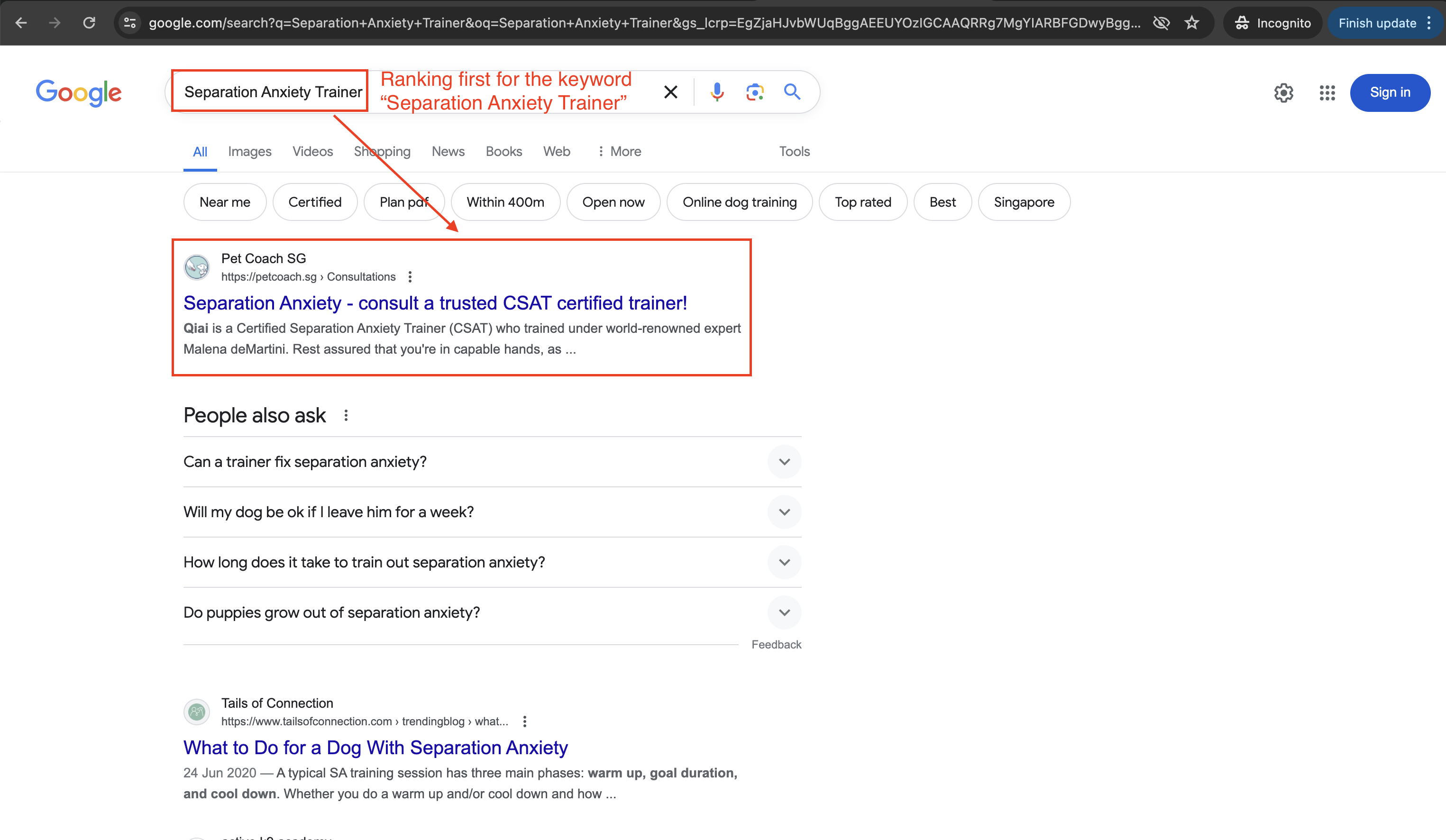
When we checked these keywords on Google, we found that they led to our landing page, which offers our separation anxiety consultation service. Upon further inspection, we noticed that three out of the top four results are serving landing pages!

This suggests that Google believes people searching for the separation anxiety trainers keywrods are looking for professionals to help with their dog’s separation anxiety. As a result, Google lists landing pages that would meet the users intent the closest!
Google is not perfect, but their algorithm is consistently improving. And in our short stint, they’ve been pretty accurate - and it’s better than just basing it on gut feel!
The next step would be for us to decide on:
- What are our target keywords
- Decide what type of content to optimise for our target keywords
Researching our target keywords
We focused on one primary keyword: Separation Anxiety Dog Training. Using the SE ranking search tool, we found a list of related keywords. We then checked the keyword difficulty and traffic volume to prioritize the most relevant ones for our optimization efforts. Here is the list of keywords we decided to target:
- dog separation anxiety training
- dog separation training
- separation anxiety for dogs training
- dog training separation anxiety
- separation anxiety in dogs training
- separation anxiety training
- dog separation anxiety training plan
- separation anxiety training for dogs
- separation anxiety dogs training
- training for dogs with separation anxiety
- training for separation anxiety in dogs
- how do you treat separation anxiety in dogs
These are the SE ranking search results for your reference: 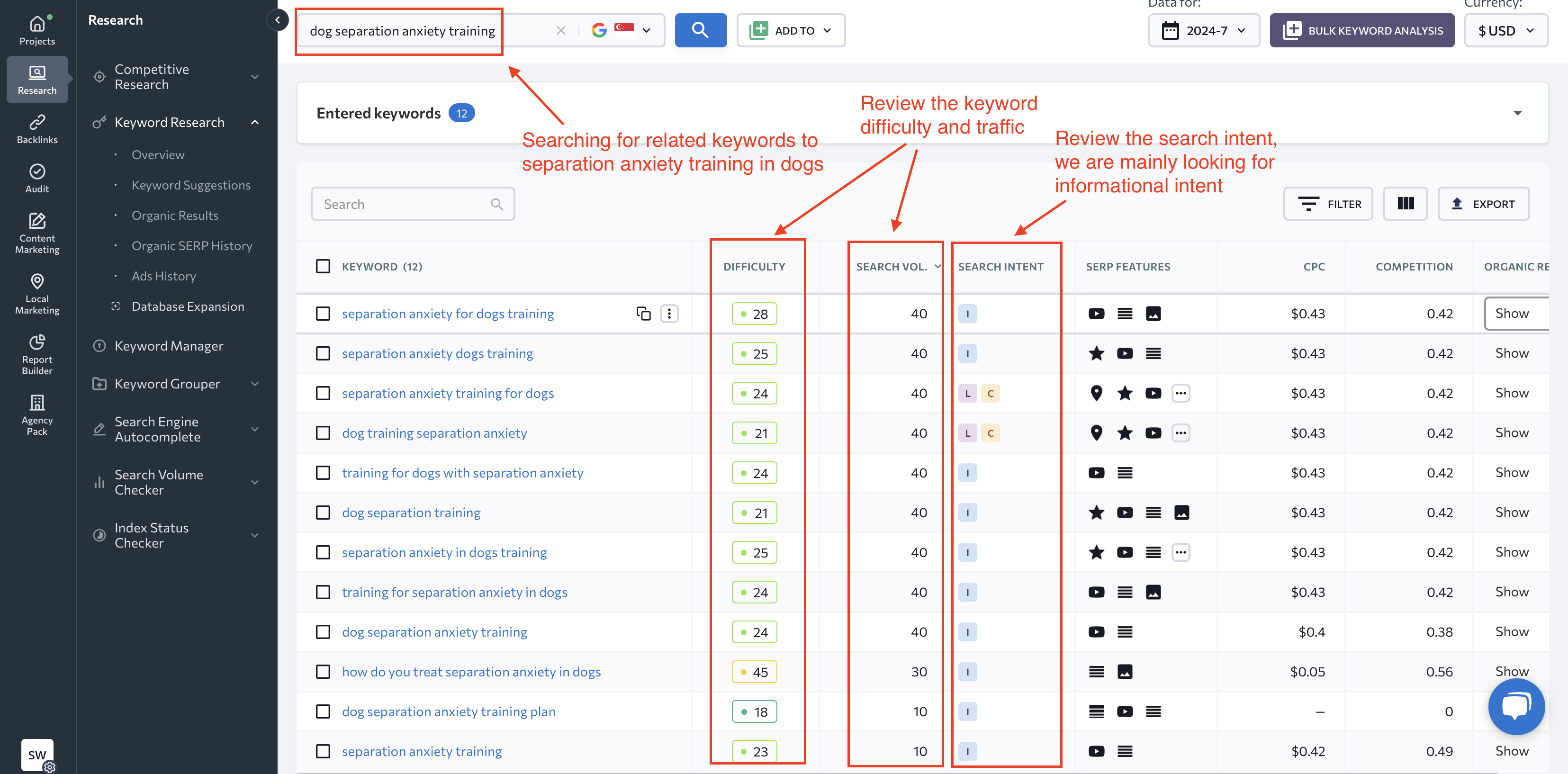
We noticed that the keyword how do you treat separation anxiety in dogs is out of our league. So we’ll scrap that!
Meanwhile, the second highest keyword difficulty is relatively less competitive. Checking the details view of the organic results for that keyword, we can see that the first results is Waggies (our competitor, duh..) with:
- Domain Trust:
24 - Page Trust:
0 - Backlinkgs:
0
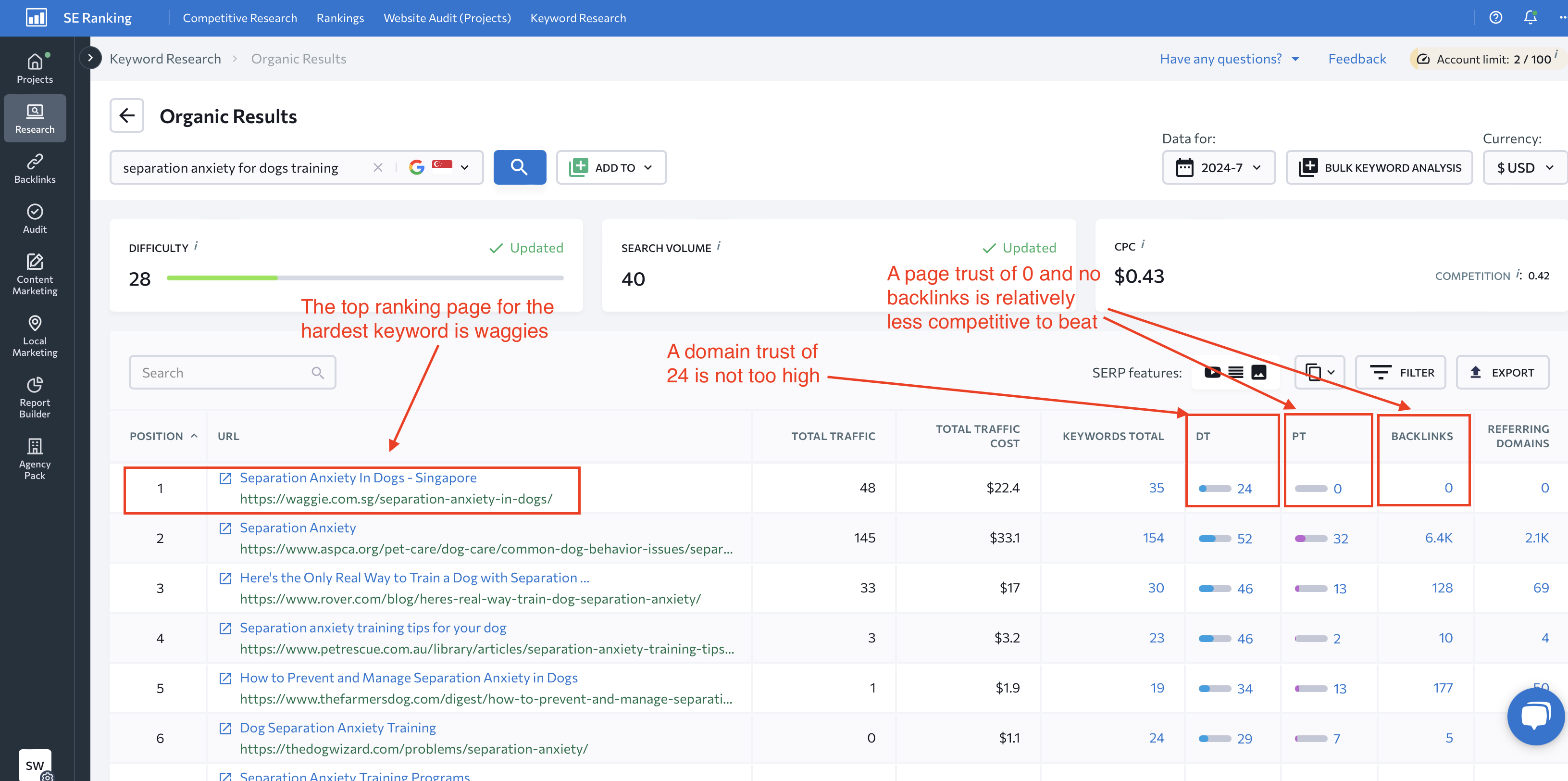
This is doable ^^ – we should go for this!
In theory, if you have the same optimized page and higher backlinks, page trust and domain trust – you should be ranking higher. In reality, the google search algorithm is complex, and these metrics are used more as guidelines to gauge the level of resources that you need to pump in before you can rank!
Confirming the Type of Content to Optimize
To determine the best type of content to optimize, we checked the type of content that is currently ranking.
First, we examined the keyword: separation anxiety for dogs training. The first result is a blog post that explains how to manage separation anxiety and their symptoms.
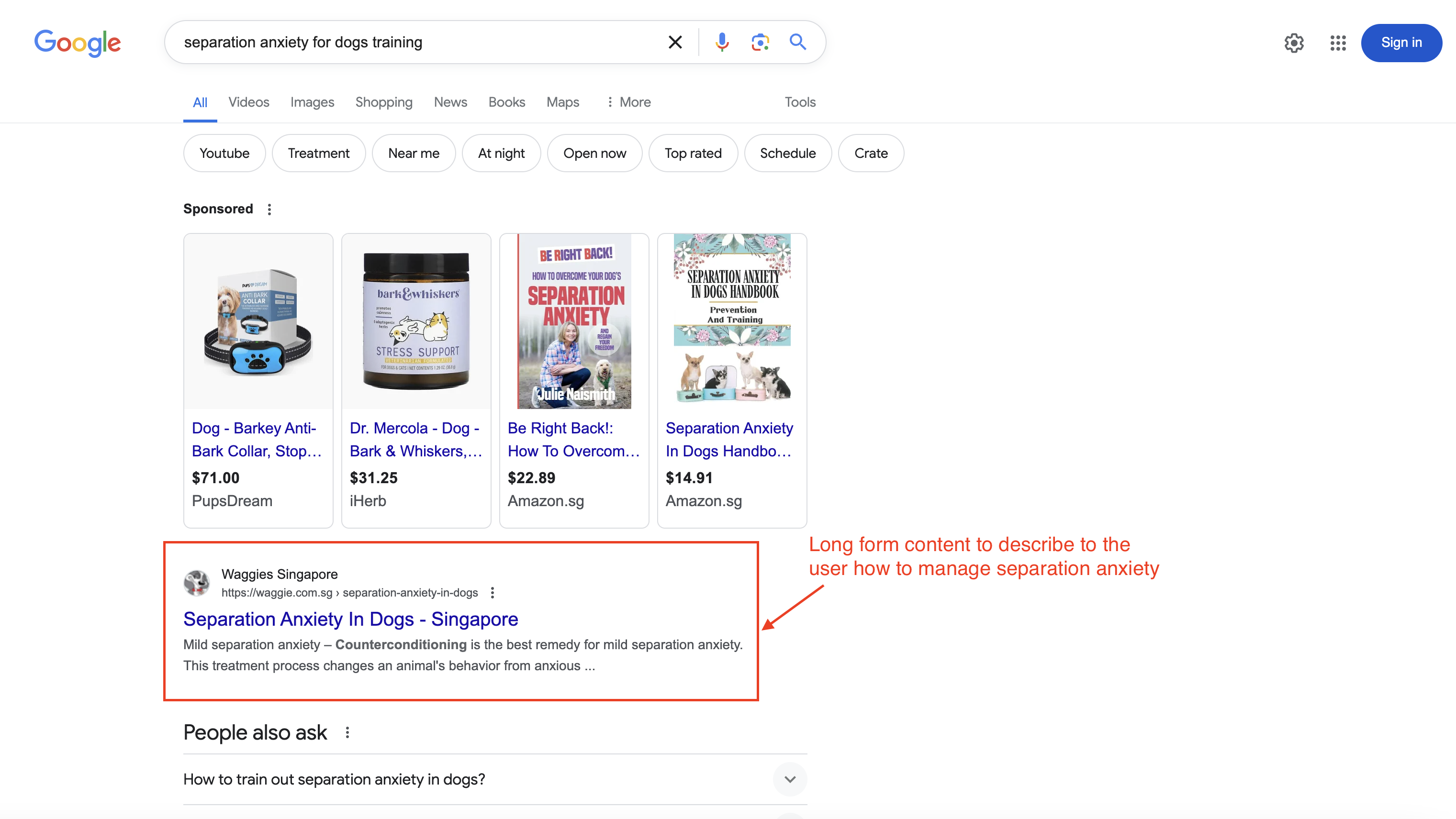
Upon further inspection, we noticed that all the top 5 results are long form blog posts, the details down the steps that you can take to manage Separation Anxiety in Dogs! Very different from the results we got when searching for Separation Anxiety Trainer! 

Based on this, we can infer that Google believes readers searching for this keyword are looking for steps on how to manage their dog’s separation anxiety or its symptoms.
Therefore, the best content type to address the reader’s needs is to create a long-form blog post that provides relevant and meaningful information.
Noticed that our Separation Anxiety Consultation page is actually ranking 6th! But this screenshot was taken after the optimisation has taken place! This mystery is not yet resolved – because although we optimised the Separation Anxiety Training page, it also improved the rankings for our Separation Anxiety Consultation page.
Fortunately, we already have a long form detailed blog post describing the separation anxiety training process. We plan to optimize this article for our target keyword. Before we proceed, We will repeat check the results of each keyword that we are planning to optimize in Google search to check user intent. This ensures that our content aligns with Google’s preference for informational long-form content that guides users through managing separation anxiety effectively.
Optimizing the Separation Anxiety Training Guide Article
Introduction to On-Page Optimization
Effective on-page optimization is crucial for improving search engine rankings and ensuring your content reaches the right audience. In this section, we’ll outline our approach to optimizing the Separation Anxiety Training Guide article.
SemRush On-Page SEO Checklist
We utilized the SemRush On-Page SEO checklist to ensure our content is fully optimized. This checklist helps us address key areas such as meta tags, headers, image alt attributes, and overall content structure.
SE Ranking Tool On-Page Audit
We conducted a comprehensive on-page audit using the SE Ranking On Page SEO Checker, syncing its findings with the SemRush SEO checklist. This process helped us identify and rectify any issues that could impact our search engine rankings.
We performed an audit before optimisation – score was about 65. We performed a re-check, another audit post optimisation!
We missed to export the results pre-optimisation, so we are unable to share the before and after audit report - but the post-optimisation audit report can be shared!
General Best Practices
We adhered to general best practices in on-page optimization, including natural inclusion of target keywords in strategic locations such as the H1 tag, title, first paragraph, and throughout the content. This ensures our content remains relevant and valuable to both readers and search engines. 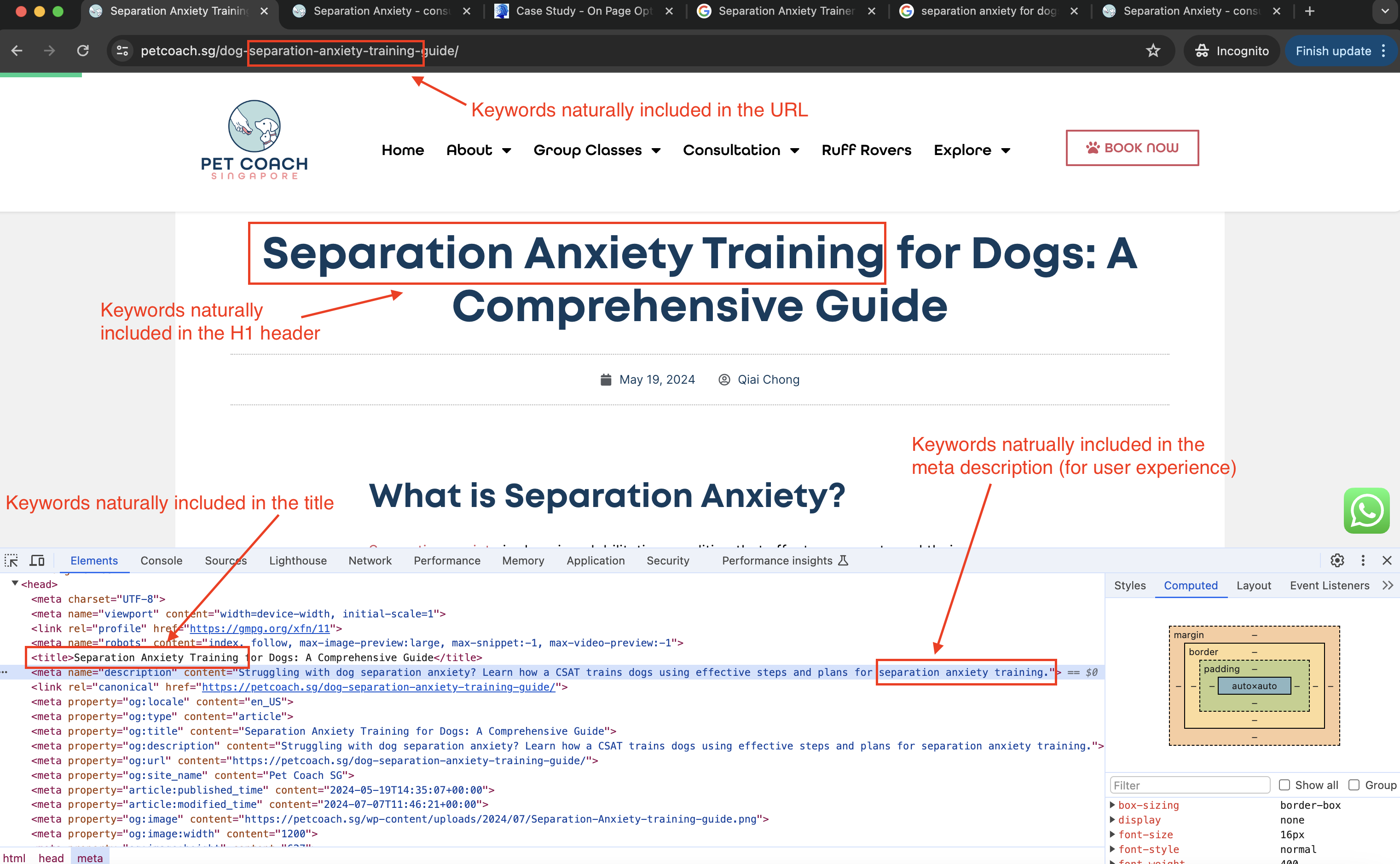
Publishing the Page
After implementing optimizations based on our audits and checklists, we published the updated Separation Anxiety Training Guide article on our website.

Rescan on SE Ranking Tool
Following publication, we rescanned the page using the SE Ranking Tool to track improvements in our search engine rankings. We continue to monitor and analyze these results to assess the effectiveness of our optimization efforts.

The score for our page quality has increased from 65 to 87 - for the curious, download the report for details! However, this does not mean anything until we can see our page actually ranking in google search for the relevant search queries we optimized for.
The next step would be to monitor Google Search Console, and SE ranking keyword tracker for the performance of our keywords!
Keyword Performance Tracking Update
We’ve recently tracked the improvement in keyword performance using data exported from Google Search Console. Here are the details:
Keyword: Separation Anxiety for Dogs Training
Our efforts in optimizing content for “Separation Anxiety for Dogs Training” have shown significant progress.
- Previous Position: 51
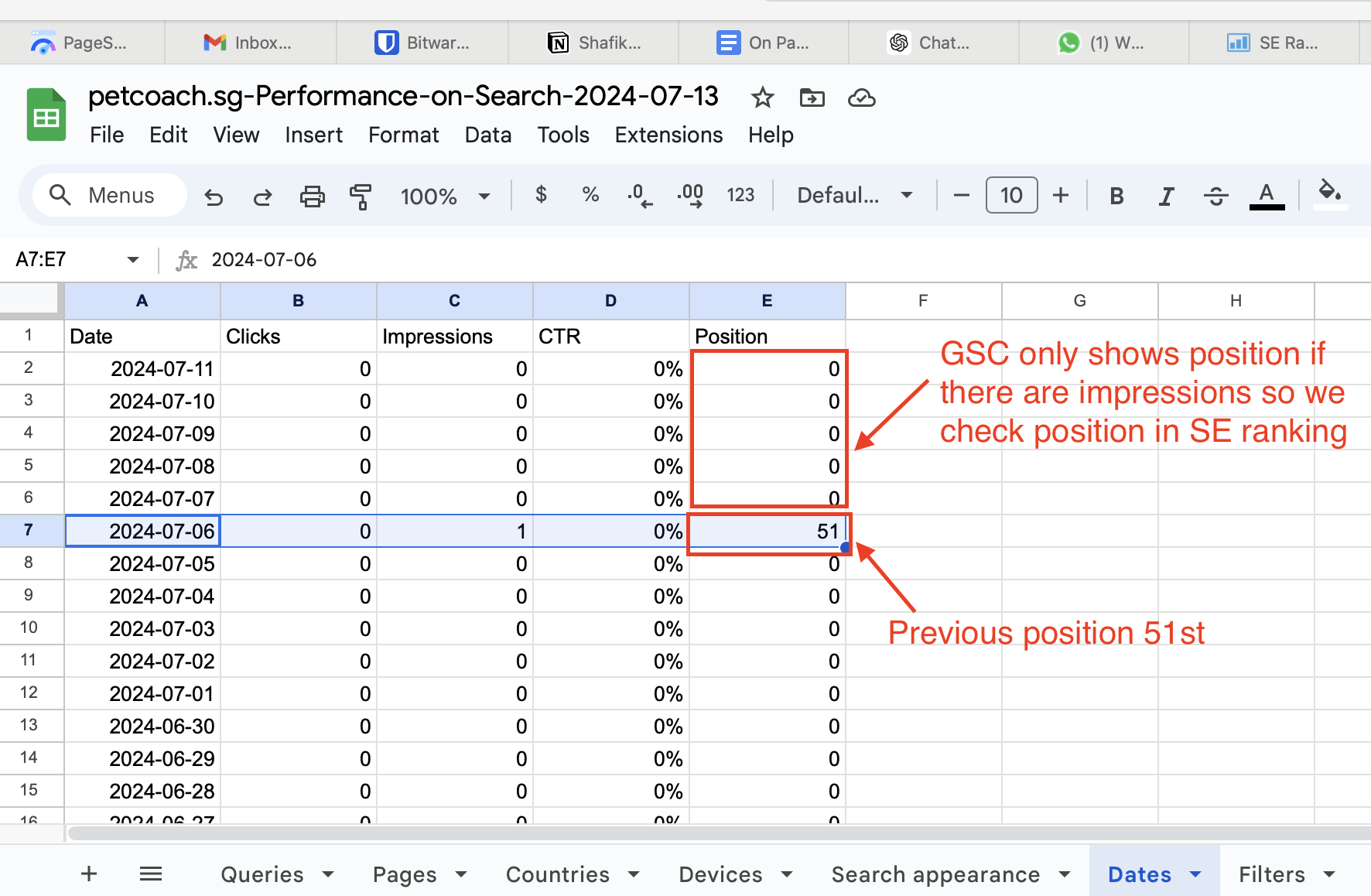
- Current Position: 7

Keyword: Separation Anxiety Dogs Training
Similarly, our focus on improving visibility for “Separation Anxiety Dogs Training” has yielded notable results.
- Previous Position: 61

- Current Position: 6

Methodology:
To accurately track our keyword performance, we utilized data from Google Search Console, focusing on exact queries related to our targeted keywords.
- Data Source: Google Search Console
- Process:
- Filtered for exact queries related to
Separation Anxiety for Dogs TrainingandSeparation Anxiety Dogs Training. - Exported and reviewed the data in the Dates tab to track changes in ranking over time.
- Filtered for exact queries related to
Google Search Console records positions only when there is an impression, which influenced our tracking approach.
Insights:
Our pages were not previously ranking prominently for “Separation Anxiety Training” related keywords, resulting in limited impressions in Google Search Console.
Following optimization efforts, we’ve significantly improved our rankings:
Separation Anxiety for Dogs Trainingnow ranks at position 7.Separation Anxiety Dogs Trainingnow ranks at position 6.
We’ve only done sample checks against the keywords that we have optimized for. For now, it seems that there are significant improvements. However, we will need to continue monitoring as SEO normally stabilizes only after a period of 2 - 6 months. There is no rule of thumb, but we like to take snapshots and comparisons in chunks of 6 weeks.
Next Steps:
Moving forward, we’re focused on sustaining and further improving our SEO strategies to maximize our keyword rankings.
- Optimization Focus: Continue monitoring and refining our SEO strategies to maintain and further improve rankings.
- Performance Tracking: Utilize SE Ranking and Google Search Console data to track ongoing keyword performance and adjust strategies as needed.
These improvements highlight our effective optimization efforts, enhancing our visibility for targeted keywords related to separation anxiety training for dogs.
Thank you!
Thanks ya’ll for reaching this far – any tips on how to better optimise. Please give me a shout out – would be keen to apply ^^
Peace and Love
Shafik Walakaka